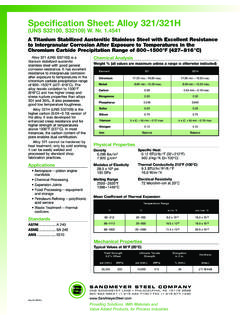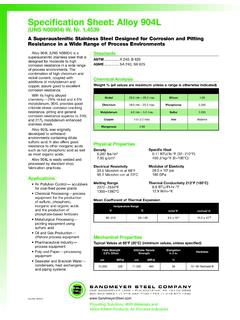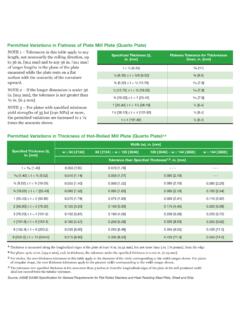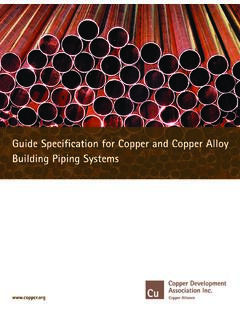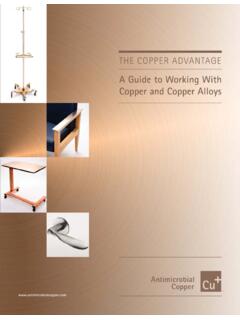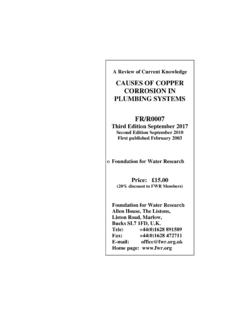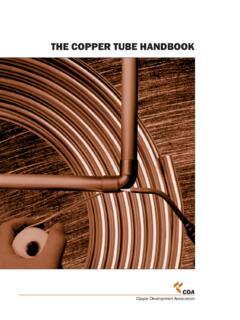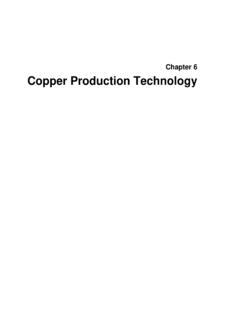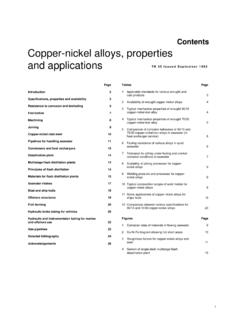Transcription of Specification Sheet: Alloy 825 (UNS N08825) W.Nr. 2
1 Alloy 825 (UNS N08825) is an austenitic nickel-iron-chromium Alloy with additions of molybdenum, copper and titanium. It was developed to provide exceptional resistance to numerous corrosive environments, both oxidizing and nickel content of Alloy 825 makes it resistant to chloride stress-corrosion cracking, and combined with molybdenum and copper , provides substantially improved corrosion resistance in reducing environments when compared to conventional austenitic stainless steels. The chromium and molybdenum content of Alloy 825 provides resistance to chloride pitting, as well as resistance to a variety of oxidizing atmospheres. The addition of titanium stabilizes the Alloy against sensitization in the as-welded condition. This stabilization makes Alloy 825 resistant to intergranular attack after exposure in the temperature range which would typically sensitize un-stabilized stainless 825 is resistant to corrosion in a wide variety of process environments including sulfuric, sulfurous, phosphoric, nitric, hydrofluoric and organic acids and alkalis such as sodium or potassium hydroxide, and acidic chloride solutions.
2 The fabrication of Alloy 825 is typical of nickel-base alloys , with material readily formable and weldable by a variety of B 424An Austenitic Nickel-Iron-Chromium Alloy Developed for Exceptional Corrosion Resistance In Both Oxidizing and Reducing EnvironmentsChemical AnalysisTypical analysis (Weight %) Specification Sheet: Alloy 825 (UNS N08825) 825 08/08 Air Pollution Control Scrubbers Chemical Processing Equipment Acids Alkalis Food Process Equipment Nuclear Fuel Reprocessing Fuel Element Dissolvers Waste Handling Offshore Oil and Gas Production Seawater Heat Exchangers Piping Systems Sour Gas Components Ni Fe Cr Mo min. max. min. min. max. min. max.* Alloy predominates remaining composition. Other elements may be present only in minimal quantities.
3 Cu Ti C Mn S Si Al min. max. max. max. max. max. PropertiesDensity lb/in3 g/cm3 Magnetic Permeability Oersted ( at 200H)Thermal Conductivity Bt -ft/hr-ft2 - F (78 F) W/m-k (26 C)Linear Coefficient of Thermal Expansion x 10-6 in / in F (200 F) 4 m / m C (93 F)Specific Heat BTU/lb - F 440 Joules/kg KElectrical Resistivity 678 Ohm circ mil/ft (78 F) cm (26 C)Melting Range 2500 2550 F 1370 1400 CModulus of Elasticity psi x (100 F) 196 MPa (38 C) Ore Processing copper Refining Equipment Petroleum Refining Air-cooled Heat Exchangers Steel Pickling Equipment Heating Coils Tanks Crates Baskets Waste Disposal Injection Well Piping SystemsApplicationsMechanical PropertiesTypical Room Temperature Mechanical Properties, Mill Annealed percent offset Ultimate Elongation Hardness Yield Strength Tensile Strength percent in 2" Rockwell B psi (MPa) psi (MPa) (50mm) 49,000 (338) 96,000 (662) 45 135 - 165 Properties Applicable to min.
4 Solutions, With Materials andValue Added Products, for Process 825 06 OffsetYield StrengthCrevice Corrosion ResistanceIntergranular Corrosion ResistanceNOTEThis technical data and information represents our best knowledge at the time of printing. However, it may be subject to some slight variations due to our ongoing research program on corrosion resistant grades. We, therefore, suggest that information be verified at time of inquiry or order. Furthermore, in service, real conditions are specific for each application. The data presented here is only for the purpose of description and may only be considered as guarantees when our Company has given written formal COMPANYC orrosion ResistanceThe most outstanding attribute of Alloy 825 is its excellent corrosion resistance. In both oxidizing and reducing environments, the Alloy resists general corrosion, pitting, crevice corrosion, intergranular corrosion and chloride stress-corrosion cracking.
5 AlloyCorrosion Rate in Boiling Laboratory Sulfuric Acid Solution Mils/Year (mm/a) 316 636 ( ) >1000 (>25) >1000 (>25) 825 20 ( ) 11 ( ) 20 ( ) 625 20 ( ) Not Tested 17 ( )Mechanical PropertiesAlloy 825 has good mechanical properties from cryogenic to moderately high temperatures. Exposure to temperatures above 1000 F (540 C) can result in changes to the microstructure that will significantly lower ductility and impact strength. For that reason, Alloy 825 should not be utilized at temperatures where creep-rupture properties are design factors. The Alloy can be strengthened substantially by cold work. Alloy 825 has good impact strength at room temperature, and retains it s strength at cryogenic Cracking ResistanceThe high nickel content of Alloy 825 provides superb resistance to chloride stress-corrosion cracking.
6 However, in the extremely severe boiling magnesium chloride test, the Alloy will crack after long exposure in a percentage of samples. Alloy 825 performs much better in less severe laboratory tests. The following table summaries the alloys performance. Table 6 - Charpy Keyhole Impact Strength of Plate Temperature Orientation Impact Strength* F C ft-lb J Room Room Longitudinal 107 Transverse 113 -110 -43 Longitudinal 106
7 Transverse 106 -320 -196 Longitudinal 91 Transverse 97 -423 -253 Longitudinal 92 Transverse 92 Resistance to Laboratory Sulfuric Acid Solutions* Average of three tests. 10% 40% 50%Resistance to Chloride Pitting and Crevice Corrosion Alloy Temp.
8 Of Onset of Crevice Corrosion Attack* F ( C) 316 27 ( ) 825 32 ( ) SSC-6MO 113 ( ) 625 113 ( ) Test (U-Bend Samples) 316 SSC-6MO 825 625 Fail Mixed Mixed Resist Fail Resist Resist Resist Fail Resist Resist ResistAlloy42% MagnesiumChloride (Boiling)33% LithiumChloride (Boiling)26% SodiumChloride (Boiling)Resistance to Chloride Stress Corrosion CrackingMixed - A portion of the samples tested failed in the 2000 hour of test.
9 This is an indication of a high level of ResistanceThe chromium and molybdenum content of Alloy 825 provides a high level of resistance to chloride pitting. For this reason the Alloy can be utilized in high chloride environments such as seawater. It can be used primarily in applications where some pitting can be tolerated. It is superior to conventional stainless steels such as 316L, however, in seawater applications Alloy 825 does not provide the same levels of resistance as SSC-6MO (UNS N08367) or Alloy 625 (UNS N06625).*ASTM Procedure G-48, 10% Ferric Chloride Boiling 65% Nitric Acid ASTM Procedure Alloy A 262 Practice C 316 34 (.85) 316L 18 (.47) 825 12 (.30) SSC-6MO 30 (.76) 625 37 (.94) Boiling 50% Sulfuric Acid-Ferric Sulfate ASTM Procedure Alloy A 262 Practice B 316 36 (.)
10 91) 316L 26 (.66) 825 1 (.03) SSC-6MO 19 (.48) 625 Not TestedResistance to Intergranular Corrosion


